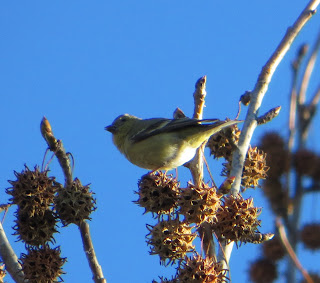Many Common Birds
Yesterday, I saw a sycamore tree full of lesser goldfinches. Below is a photo of one of the goldfinches; a female. Sycamore trees seem to be very popular with goldfinches. They like to eat the seeds.
 |
| Lesser Goldfinch |
Today I saw a northern mockingbird standing on a telephone pole (singing, of course). Below is a photo.
 |
| Northern Mockingbird |
A Bewick's wren came right up to me again when I made 'pst' noises. If you are trying to get a wren closer, 'pst' and 'psh' noises have never failed yet. Here is the wren.
 |
| Bewick's Wren |
A black phoebe also came when I made the noise, which had never happened before. It probably came just out of curiosity, because phoebes do not made any 'pst' noises. They only make cheeping noises. Here is the phoebe.
 |
| Black Phoebe |
I've been seeing more mourning doves than Eurasian collared-doves, which is good, because mourning doves are native. Eurasian collared-doves do not migrate, but there seem to be less of them in winter, and I'm not sure why. Mourning doves are very common doves found throughout the United States, southern Canada, and Mexico. They are grayish-brown, and unlike the larger collared-doves, they do not have a collar, have long, pointed tails, and have black spots on their wings. They are often found in groups in suburban areas, farmland, or other habitats with brush and open areas. They are called 'mourning' doves because their song (cooing) sounds mournful. Here are three photos of the doves.
 |
| Mourning Dove |
 |
| Mourning Dove |
 |
| Mourning Doves |
No comments:
Post a Comment